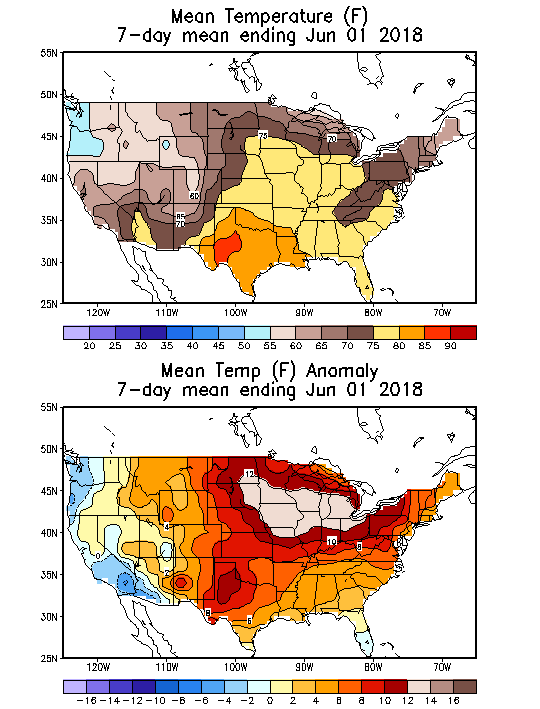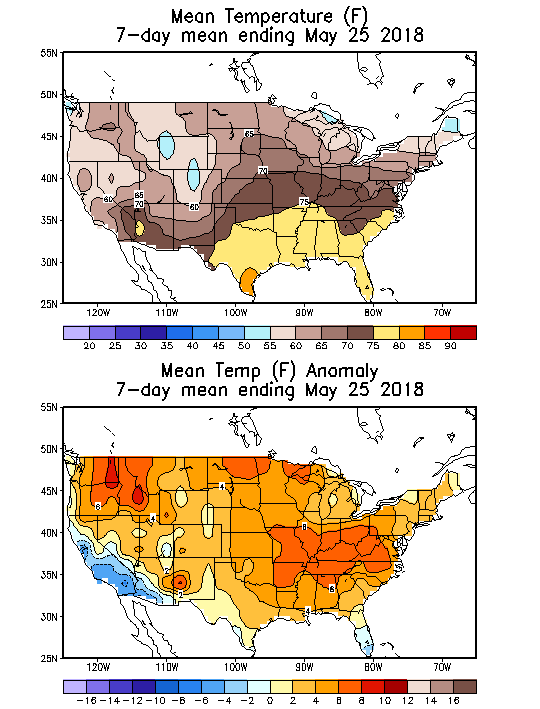
This is how we ended last week.........VERY bullish:
From Natural Gas Intelligence:
Hotter June Outlook Supporting Natural Gas as Futures Gain; Spot Prices Mixed
Natural gas futures inched higher Friday in a range-bound session following Thursday’s rally, with hotter June temperatures and a leaner-than-expected weekly storage report continuing to lend support to prices. The spot market saw mostly small adjustments heading into the weekend, with notable exceptions being steep declines in the Northeast and some double-digit gains in the West; the NGI National Spot Gas Average eased 3 cents to $2.57/MMBtu.
Rig count for oil and natural gas.
Oil up 2, ng down one.............no big deal.
VS a year ago, oil up 128, ng up 15. Maybe bearish longer term?
Seasonals turn negative here. Models are also not quite as hot as they were for later in June.
The bullish EIA reports vs expectations recently have been a big reason for price strength. Not sure if that is dialed in below $3 but it might be if we don't shift the heat farther east to the East Coast.
Injections will be low this Summer if the heat is widespread to the East Coast. Storage is pretty low here, so injections need to be above historical averages for the next 6 months to catch up.
The chart below is July Natural Gas for the past year:
https://www.nasdaq.com/markets/natural-gas.aspx?timeframe=1y
| |
From Natural Gas Supply Association:
The residential-commercial sector is expected to account for the third-largest increase in demand for gas for the April-October summer cooling season, although some of this growth is attributable to high demand this April when unseasonably cold weather kept furnaces and water heaters blasting longer than normal.
The industrial sector is expected to slightly increase its summer consumption of gas to average out at 21 bcfd—an increase of only 0.5 bcfd over last summer. Industrial demand is spurred mainly by newbuilds and expansions in petrochemicals, fertilizers, and steel.
Storage
Heading into the winter heating season, it is projected that 3,507 bcf of gas will be in storage by yearend, which would require an average weekly injection of 70 bcf. This level of injection is robust and larger than last summer’s average weekly injections of 57 bcf, but much less than the summer of 2014’s average weekly injections of 89 Bcf.
The difference in the size of the weekly injections between the summers of 2017 and 2018 is expected to place upward pressure on natural gas prices this summer.
US gas production this summer will reach 80.4 bcfd, a sizeable increase over last summer’s 72.5 bcfd, according to the US Energy Information Administration’s forecasts.
From Natural Gas Intelligence this morning:
June Natural Gas Called Slightly Higher As Hot Weather Outlooks Persist
9:17 AM
"June natural gas futures were set to open less than a penny higher at $2.967 as weather models retained a warm pattern for the next couple of weeks."
My forecast here on Monday, is not as hot as Friday's forecast.
metmike
Memorial Day week 2018, the week this Thu's EIA report will cover, had the highest CDD of any Mem. Day week back at least to 2000: 60. This 60 is also the earliest in the season going back to 2000. As a result of this unusually early heat, I'm expecting a much below average Memorial Day week injection. Here's why:
Memorial Day weeks:
CDD EIA Year
60 ? 2018
57 +77 2006
55 +62 2012
55 +80 2011
52 +65 2016
51 +99 2010
38 +110 2007
37 +119 2014
36 +102 2004
32 +132 2015
31 +111 2013
30 +106 2017
30 +124 2009
30 +105 2008
26 +105 2005
25 +114 2003
Average Mem. Day week injection 2003-2017: 101
Note that all 100+ injections were for weeks with 38 or fewer CDDs. Even the pretty tight 2017 had +106 with its pretty low 30 CDDs. Even the pretty loose 2011 had only +80 with its pretty high 55 CDDs.
I have 2018 looser than 2016 by ~20 bcf/week. Otherwise, 2016's +65 would suggest we could see as low as +55. It is also tighter than 2017. I have 2018 a bit tighter than 2014/2015.
The prior week's CDDs were only 31 meaning an increase of a whopping 29 over the prior week. With that much of an increase, I can't see this week's report being near or higher than last week's +96. When I add it all up, I favor only 80s for this week's report with the very warm 60 CDD despite it being Memorial Day week. Even the high 70s are not out of the realm of possibilities.
My official guess: +85
Any other opinions/guesses?
Edit: This should already be dialed in by the market.
Thanks for the comprehensive post Larry. This is one of those that I will copy and print out.
As I mentioned this morning, my forecast was cooler than the one from late last week.
The 12Z GFS, however was pretty hot.
Here were the closing comments from NGI:
July Natural Gas Futures Fall as Forecasts Hint of Cooler Weather; Supply Points Rally
5:42 PM
After a sluggish start to Monday trading, natural gas futures failed to get off the ground as weather outlooks trended slightly cooler in the medium term. Spot prices were mixed, and unusually so, as some southeastern pricing hubs weakened despite intense heat blanketing the region while Northeast points surged despite softer demand on tap beginning Tuesday. The NGI National Spot Gas Average rose 6.5 cents to $2.635/MMBtu
Temps last week:

Temps for the previous reporting period:

The models are still suggesting that the pattern might change to cooler during week 2.
However, the European model 30 day forecast that was just updated has blistering heat across the midsection, spreading east for a few days early in the last week of the month. The heat recedes for several days at the end of June then comes surging back during the first week of July. Take it with a grain of salt but here are the impressive maps:
850 isotherms, starting June 26/27 going thru July 6/7:
Mike,
You're welcome. Those maps sure are telling about how much hotter last week got!
Edit: I'm talking about Mike's prior post as he posted his last post at about the same time I was typing this one. I'll comment on the Euro monthly in my next post.
Look at the difference from the hot looking 12Z GFS below, to the latest one under that.
gfs_namer_372_200_wnd_ht | gfs_namer_372_500_vort_ht |
gfs_namer_372_1000_500_thick | gfs_namer_372_850_temp_ht |
Latest GFS below
gfs_namer_384_200_wnd_ht | gfs_namer_384_500_vort_ht |
gfs_namer_384_1000_500_thick | gfs_namer_384_850_temp_ht |
Mike,
I know you know this. So, these comments are mainly for others.
Mike's two prior posts are quite illustrative about how little skill models have near the end of week 2, much less the timeframe of the Euro maps that were posted. At hour 372 (what Mike posted), the GFS flips all the time. It even flips a lot, though not as often, at just hour 240. That's why ensemble means are often the preferred way to go once into week 2. And even they can be jumpy in week 2. Now, going out 500-700+ hours like Mike showed on the Euro monthly? Imo, those have WAY more entertainment value than actual predictive value. Climo is just about as good at that range. And that's keeping in mind that the Euro is the best model.
Exactly right on everything you stated Larry!
We try to best represent the physical laws of the atmosphere using mathematical equations and plug in all the data from the surface to the top of the atmosphere, then run it out in time for various parameters.
A slight variation in 1 parameter and you can have a completely different solution. Since there is no "perfect" model, the ensembles represent a model with slight variations in different parameters. Each ensemble, with its slight variation gives a forecast.
There can be an extreme range in solutions/forecasts when you get out to the 2nd week of the ensembles but we find that when there is a consensus between a large number of solutions, it increases the confidence of that solution.
Also, like you said, averaging all the solutions to get the ensemble average, minimizes the extreme, outlying solutions, which tend to be wrong.
I have noticed that the European model ensemble average changes drastically in week 2 at times........much more than the GFS and Canadian model ensembles.......which usually just have small run to run changes.
Any thoughts on that Larry?
Also, the ensemble average does not do as well sometimes with an extreme pattern developing for obvious reasons. The more extreme, individual solutions will have the best idea but other less extreme or even opposite solutions will shift the ensemble average away for the extreme pattern coming up.
But the ensemble average is the most consistent and accurate overall by a wide margin
Mike, I'll get back to you with my thoughts hopefully later tonight.
Edit: Mike, I haven't noticed the Euro ensemble being more jumpy than the GFS and CDN ensembles, but that may be because I haven't caught onto this. Assuming it really is more jumpy, I don't have an explanation. If anything, you'd think the Euro would be more stable with its whopping 50 members. Perhaps these 50 members aren't as independent of each other as the members of the other two ensembles for some reason?
When comparing the GFS and Euro ensemble jumps, could part of the bigger jumps of the Euro be because they are 12 hours apart vs the 6 hours of the GFS?
Being spaced 12 hours apart could be part of it but they are more jumpy than the Canadian ensembles too.